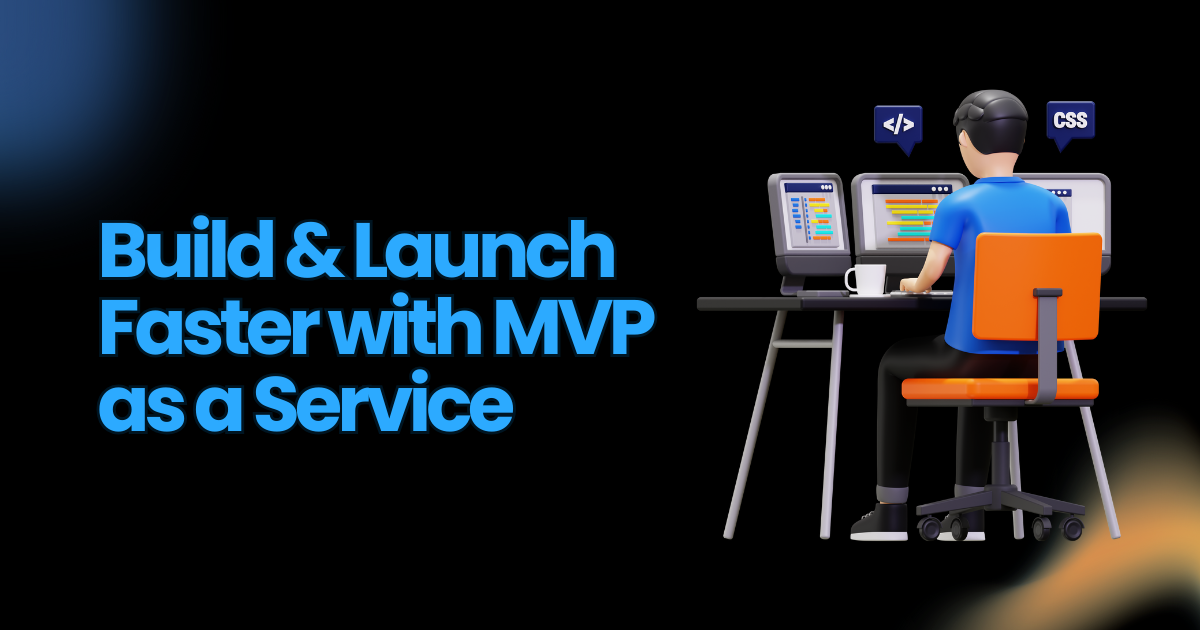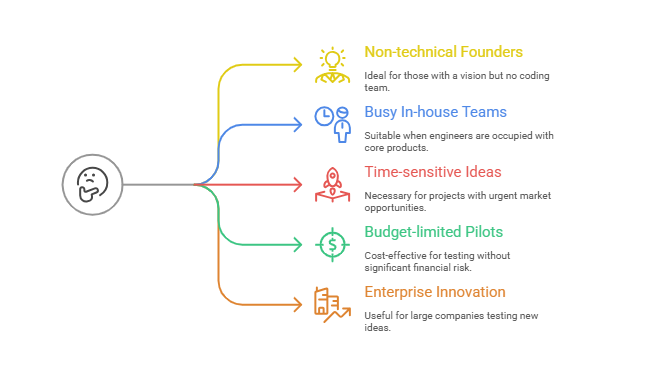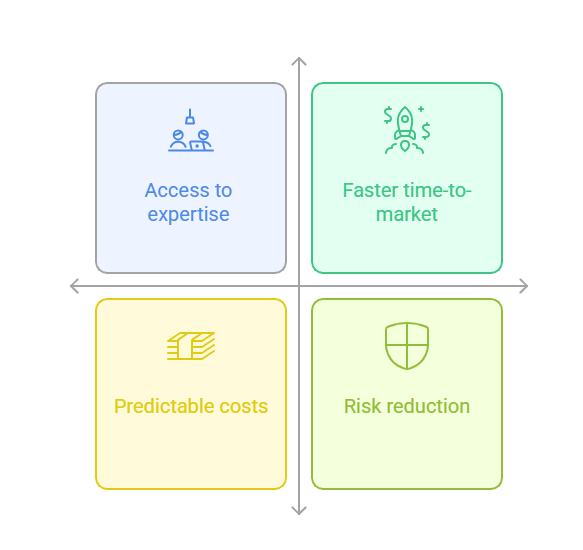
Launching a new product is exciting, but also risky. Many businesses burn months of time and thousands of dollars building something that users don’t even want. That’s why the idea of the Minimum Viable Product (MVP) came into play — a way to test, validate, and learn quickly before making a heavy commitment.
Now, there’s a newer model called MVP as a Service. Instead of trying to build an MVP yourself or hiring a large in-house team, you work with a specialized partner who handles everything from discovery to launch. Think of it as having a dedicated launch team whose only focus is getting your idea into the hands of real users, fast.
This article will walk you through what MVP as a Service means, how it works, why businesses use it, and what to expect.
From MVP to MVP as a Service
An MVP, or Minimum Viable Product, is the most basic version of your product that still solves a real problem for your target users. It has just enough features to test the core idea, gather feedback, and see if the concept is worth pursuing.
The problem? Many teams get MVPs wrong. They either overbuild and end up wasting money, or they underbuild and fail to impress users. Non-technical founders often struggle even to assemble a team, while larger companies find it hard to move quickly because of internal priorities.
That’s where MVP as a Service (MVPaaS) comes in. It’s a packaged offering where a team of experts builds your MVP end-to-end — strategy, design, development, testing, and even the launch.
What Makes MVP as a Service Different?
Here’s a simple comparison to see how MVP as a Service stands apart from traditional outsourcing or building in-house:
| Aspect | MVP as a Service | In-House / Traditional Outsourcing |
| Scope | End-to-end: discovery, design, build, launch | Usually limited to development or design |
| Timeline | 4–12 weeks typical | 12–24 weeks for in-house, longer for full outsourcing |
| Cost | Predictable, milestone-based | Uncertain, often overruns |
| Focus | Speed + validated learning | Delivery of full spec, less flexible |
| Risk | Lower (lean approach) | Higher (big upfront investment) |
In short, MVP as a Service is designed to get you moving quickly with less risk.
When Should You Use MVP as a Service?

Not every project needs MVPaaS, but it’s a great option in several situations:
● Non-technical founders – You have a vision but no coding team.
● Busy in-house teams – Your engineers are tied up with core products.
● Time-sensitive ideas – Market opportunity won’t wait six months.
● Budget-limited pilots – You want to test without burning a fortune.
● Enterprises testing innovation – Large companies often use MVPaaS for pilot projects or internal experiments.
Benefits of MVP as a Service

There are several reasons businesses lean toward this model:
1. Faster time-to-market
Most MVPaaS providers can launch an MVP in 4–12 weeks, compared to 6–12 months for traditional builds. That speed can be the difference between being first in the market or playing catch-up.
2. Predictable costs
Instead of runaway budgets, MVPaaS engagements are usually milestone-based, which keeps costs predictable.
3. Access to expertise
You don’t just get developers. You also get product strategists, designers, QA testers, and DevOps support in one package.
4. Risk reduction
By validating early, you avoid sinking resources into products that don’t resonate.
5. Easy transition to growth
A well-structured MVP can be scaled further, handed off to an internal team, or extended by the same service partner.
Comparing Different Approaches
Here’s a high-level view of how MVPaaS compares with other models:
| Metric | In-House MVP | MVP as a Service | Full Product Build |
| Timeline | 12–24 weeks | 4–12 weeks | 6–12 months |
| Cost accuracy | ±30–50% | ±10–20% | ±40–100% |
| Failure risk | High | Moderate | Very high |
| Overheads | High (hiring, management) | Low | Very high |
This makes MVPaaS particularly attractive when speed and cost control matter most.
The MVP as a Service Process
Most providers follow a structured approach. Here’s how it usually looks:
1. Discovery & Strategy
● Market research
● Competitor analysis
● User personas
● Defining MVP scope
2. Design & Prototyping
● Wireframes
● User flows
● Clickable prototypes
3. Development & Engineering
● Core features built
● Integration with third-party services
● Secure, scalable setup
4. Testing & QA
● Unit and integration testing
● Usability testing
5. Launch & Deployment
● Beta release
● Early adopter onboarding
5. Feedback & Iteration
● Collect metrics
● Decide whether to pivot, persevere, or scale
Key Challenges and How to Handle Them
Even with MVPaaS, challenges exist:
● Scope creep: Founders often want “just one more feature.” The cure is discipline: only what’s needed to validate.
● Communication gaps: Regular updates and shared dashboards keep teams aligned.
● Vendor lock-in: Always insist on full documentation and code handover.
● Time zone issues: Choose providers who align with your working hours or have strong communication culture.
Real-World Use Cases of MVP as a Service
MVP as a Service isn’t just a theory. Companies across industries use it to test ideas quickly and reduce the cost of failure. Here are some common scenarios where MVPaaS shines, with practical details and outcomes.
1. Marketplace Startups
A founder wants to test whether users are willing to book services through a local marketplace. Instead of building a full-blown platform with advanced search, reviews, and payment features, the MVP includes:
● Basic sign-up for users and service providers
● Simple listing creation
● A direct booking or request form
● Payment integration with a single gateway
● Outcome: Within 8 weeks, the platform launches, attracting 200 users and 40 providers. Data shows high interest in one service category, allowing the founder to focus resources there instead of spreading thin.
● Lesson: Early demand signals are often uneven. An MVP helps you spot the “hot zone” before scaling.
Turn Your Idea into a Market-Ready MVP with EnactOn
Validate faster, cut risks, and launch in weeks with our MVP as a Service model.
Connect with our team today!
2. SaaS Dashboards for B2B
A startup wants to sell analytics dashboards to small businesses. Instead of building dozens of charts and integrations, the MVP includes:
● Data upload in CSV format
● A handful of pre-built charts
● Role-based access for a small team
● Email notifications for one or two triggers
● Outcome: Within 10 weeks, the first paying customer signs up. Feedback shows that users value the email triggers more than the fancy charts, guiding the next build phase.
● Lesson: What you think is the “main feature” may not be the real value driver. MVP feedback reveals the truth.
3. Enterprise Innovation Labs
Large companies often need to test ideas without disturbing their core operations. One insurance company wanted to automate claims verification. Instead of a massive integration project, the MVP included:
● Login for internal staff
● Upload of claim documents
● A simple AI model to classify documents
● Manual review workflow for exceptions
● Outcome: In 6 weeks, the internal pilot runs with 50 employees. Time per claim drops by 25%, enough evidence for the leadership team to approve full rollout.
● Lesson: Enterprises don’t always need perfection to move forward. A lightweight MVP can prove value quickly and unlock bigger budgets.
4. Mobile App Startups
A fitness founder wants to launch a mobile app for personalized workouts. Instead of a complex app with AI, wearable integrations, and social features, the MVP focuses on:
● User profile and goal setup
● A library of pre-set workouts
● Progress tracking with basic charts
● Push notifications for reminders
● Outcome: Launched in 7 weeks, the app reaches 1,000 downloads. Usage data shows people prefer “quick workouts under 15 minutes,” prompting the founder to double down on micro-routines.
● Lesson: MVPs help uncover actual user behavior, which may differ from assumptions.
5. E-commerce Experiments
A fashion entrepreneur wants to see if people will buy curated outfits online. Instead of building a full e-commerce site with logistics and warehousing, the MVP includes:
● A simple Shopify store
● 20 curated outfits listed
● Manual order fulfillment with drop shipping
● Email updates for tracking
● Outcome: The store launches in 3 weeks, with the first 50 orders coming organically. Manual fulfillment validates demand before investing in full logistics.
● Lesson: MVPs are not always about technology. Sometimes, manual processes behind the scenes are enough to test a concept.
6. Fintech Pilots
A startup wants to test a peer-to-peer lending idea. A full fintech build would require licenses, integrations, and heavy compliance. The MVP includes:
● A small user pool (invitation-only)
● Wallet balances handled through a third-party payment service
● Simple lending and repayment records
● Manual approval process for loans
● Outcome: The MVP runs as a closed pilot for 100 users. Early repayment rates and interest willingness are tracked, providing crucial data for investor pitches.
● Lesson: In regulated industries, MVPs can be staged pilots that generate data without breaking compliance rules.
7. HealthTech Trials
A founder wants to launch a telemedicine platform. Instead of building secure video, EHR integrations, and prescriptions, the MVP includes:
● Appointment booking
● Video calls using a third-party API
●Simple symptom logging
● Payment collection
● Outcome: Launched in 6 weeks, 300 patients complete consultations. Doctors highlight that “follow-up reminders” are more valuable than real-time video quality, steering future development.
● Lesson: Healthcare MVPs show what matters most to patients and doctors, which may not align with founder assumptions.
8. Internal Tools for SMEs
A medium-sized company wants a task management tool customized for their workflows. Instead of adopting an expensive SaaS license, they hire an MVPaaS team to:
● Build a simple web app with tasks, status, and deadlines
● Add role-based permissions
● Integrate with email for notifications
● Outcome: In 5 weeks, employees start using it, leading to a 15% drop in missed deadlines. The MVP proves enough value to replace spreadsheets, saving hours weekly.
● Lesson: Even SMEs can use MVP SaaS to solve specific internal pain points.
Metrics to Track After Launch
Building the MVP is only half the story. You need to measure what happens after launch.
| Metric | Why It Matters | Example Target |
| Activation rate | Shows if users find value quickly | 20–40% |
| Retention rate | Indicates if users keep coming back | 40% after 7 days |
| Conversion | Validates if people are willing to pay | First 5–10% |
| NPS (Net Promoter Score) | User satisfaction | Above 30 |
| Bug/Error rate | Technical stability | As low as possible |
These numbers tell you whether to scale, pivot, or pause.
Best Practices for Working with an MVPaaS Partner
If you go this route, here are tips to make it work:
1. Start with a clear vision and success criteria.
2. Be strict about scope — validate, don’t overbuild.
3. Involve users early, even with prototypes.
4. Stay engaged with weekly updates and demos.
5. Demand documentation and code ownership.
6. Plan from the start how you’ll transition after the MVP.
What Comes After the MVP?
Once your MVP is live and tested, you have three choices:
1. Pivot – Adjust direction if your assumptions were wrong.
2. Persevere – Keep refining if feedback is positive.
3. Scale – Start building the full product with more features.
The good news is that with MVPaaS, the handover to scaling — whether to your in-house team or the same partner — is smooth because the foundations are already set.
Final Thoughts
Ideas are everywhere, but execution is what counts. The mistake many businesses make is trying to execute too much, too soon. That’s why MVP thinking became so powerful — and why MVP as a Service is becoming a go-to model.
By using an experienced partner to build your MVP, you can move faster, spend smarter, and validate with real users before committing fully. Whether you’re a first-time founder or an established business testing a new idea, MVP as a Service could be the lean, smart path to take.
With experience delivering 500+ projects for clients across 65+ countries and industries like SaaS, fintech, healthtech, and e-commerce, EnactOn brings the global expertise you need to launch with confidence. If you’re ready to turn your idea into a validated product, explore our MVP as a Service offerings today.
FAQs
What is MVP as a Service?
It’s an end-to-end model where a specialized team handles everything from strategy to launch, helping you validate your idea quickly without building a full product.
How long does it take to build an MVP with Enacton?
Most MVPs can be launched within 4 to 12 weeks, depending on the complexity of features and integrations required.
What types of businesses can use MVP as a Service?
Startups, SMEs, and even large enterprises use MVP as a Service — whether for testing a new idea, running a pilot project, or validating a feature before scaling.
Do I still need an in-house team if I choose MVP as a Service?
Not at the MVP stage. Our team covers strategy, design, development, and testing. You can decide later whether to scale with us or transition to an internal team.
How much does MVP as a Service cost?
Costs vary based on scope, but the model is designed to stay lean and predictable. You’ll only invest in what’s essential to validate your product idea.
